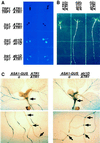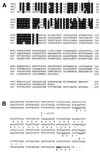A Myb homologue, ATR1, activates tryptophan gene expression in Arabidopsis
- PMID: 9576939
- PMCID: PMC20434
- DOI: 10.1073/pnas.95.10.5655
A Myb homologue, ATR1, activates tryptophan gene expression in Arabidopsis
Abstract
In Arabidopsis thaliana, tryptophan pathway genes are induced in response to starvation, wounding, and pathogen attack, resulting in increased production of tryptophan and secondary metabolites important for development and defense. The Arabidopsis tryptophan pathway therefore provides an ideal system for elucidating how environmental stimuli are transduced into changes in plant gene expression. To characterize the factors that regulate the first gene in the pathway, ASA1, which is the key point of control, we have isolated altered tryptophan regulation (atr) mutants with deregulated expression of ASA1. One of these mutants, atr1D is dominant for increased transcription of ASA1 in specific seedling tissues. We have used atr1D to clone the ATR1 gene based on its map position. ATR1 encodes a Myb-like transcription factor that modulates ASA1 expression. The ATR1 transcript also includes a 5' regulatory region with three short ORFs, one of which is prematurely terminated by the atr1D mutation. Thus, ATR1 defines the first characterized tryptophan gene regulator in plants, and the atr1D mutation defines a sequence important for ATR1 expression.
Figures




References
Publication types
MeSH terms
Substances
Associated data
- Actions
LinkOut - more resources
Full Text Sources
Other Literature Sources
Molecular Biology Databases
Miscellaneous

